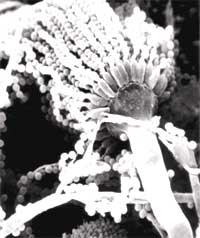Life industry goldrush
 in the us, they are clubbed under the curious heading of 'Life industry': giant transnational enterprises which buy, sell and control the market for bio-industrial products. These enterprises thrive on biological materials (plants, animals and microorganisms). From seeds and agrochemicals to pharmaceuticals and veterinary medicines, these corporate heavyweights cater to consumers across the world.
in the us, they are clubbed under the curious heading of 'Life industry': giant transnational enterprises which buy, sell and control the market for bio-industrial products. These enterprises thrive on biological materials (plants, animals and microorganisms). From seeds and agrochemicals to pharmaceuticals and veterinary medicines, these corporate heavyweights cater to consumers across the world.
The global pharmaceutical market is worth around us $197 billion and the top 10 pharmaceutical corporations in North America account for a staggering 43 per cent of this. The secret of their success: dramatic development in the field of 'microbial biotechnology', which is a process in which microorganisms are used to develop drugs, vaccines, food, pesticides, fertilisers and a variety of other commodities.
Little wonders Microorganisms are scientifically defined as "biological substances which are self-replicable or are replicable via a host organism (animal or plant tissues)". The various forms of microorganisms are bacteria, algae, fungi and viruses, which can be found everywhere on the planet - in the soil, in water, air or the sea. Some are even found to grow on animal and plant tissues.
Although microbial biotechnolgy, coupled with favourable patent laws, conjures up images of millions of dollars for the West, the present situation in India is not suitable for giving patent protection to micro-organisms, say legal experts. Besides, the technological gains from patent protection at this stage will not outweigh the losses from such a measure, they say. Scientists, however, disagree, stressing that patenting microorganisms will attract multinational corporations to the country, leading to a direct interaction between scientists and corporations and, consequently, to better research facilities.
The us Patents and Trademark Office (pto) operates on the principle that if an individual or an organisation files a patent on a microorganism that is 'new' (not previously known by humankind), and can prove that it has an industrial application, the patent will be granted. Moreover, the process by which a consumer product - a vaccine, for example - is developed by using a microorganism, is also patentable. And the patentee will enjoy a monopoly over the end product as well. The us pto also grants patents on higher life-forms like plants and animals. The rest of the world has, however, not made up its mind yet about allowing an industry or an individual to establish monopoly control over a living entity.
The World Trade Organization (wto), which lays down the rules and principles governing global trade, reflects this dilemma. In the chapter on the Trade Related Intellectual Property Rights (trips) in the wto's charter, Article 27.2 says that countries may exclude certain matters from patents for reasons of "public morality". Plants and animals are included in this category, while microorganisms are not. trips makes it obligatory for its members to provide patents for "microorganisms and microbiological processes". The term microorganism, however, has not been defined in the wto charter.
The European patent scenario is essentially similar to the wto charter. Article 53 (b) of the European Patent Convention implemented by the European Patent Office (epo), says no protection is available for "plant or animal varieties or essentially biological processes for the production of plants or animals", but "this provision does not apply to microbiological processes or the products thereof". Chapter iv of the Guidelines for Examination issued by the epo lays down that "to find a substance freely occurring in nature is a mere discovery, and therefore, unpatentable".
Significantly, the clause goes on to state: "However, if a substance found in nature has first to be isolated from its surrounding and a process for obtaining it is developed, that process is patentable. Moreover, if the substance can be properly characterised either by its structure, by the process by which it is obtained or by other parameters
